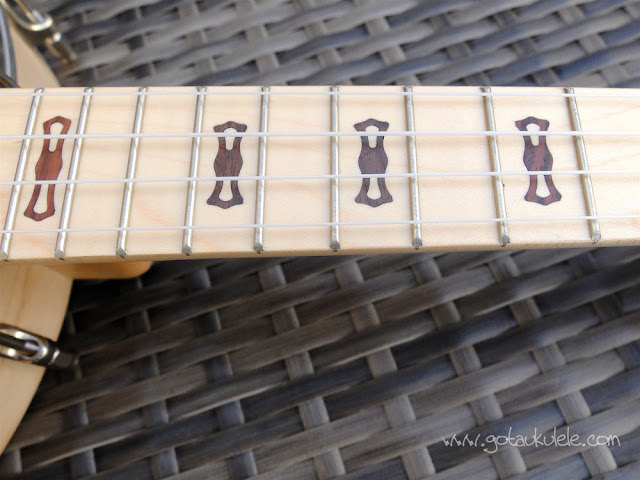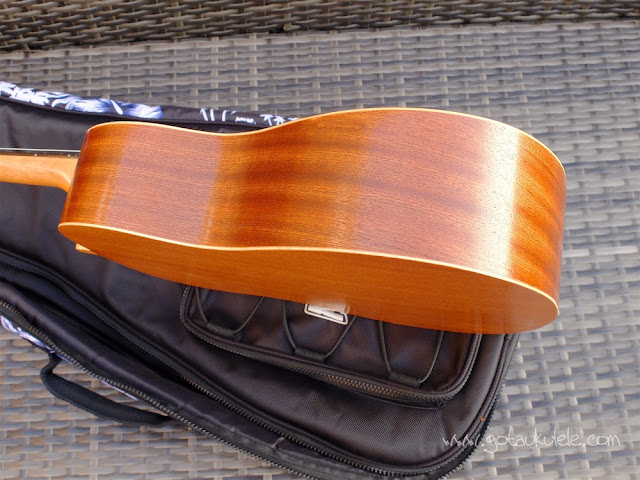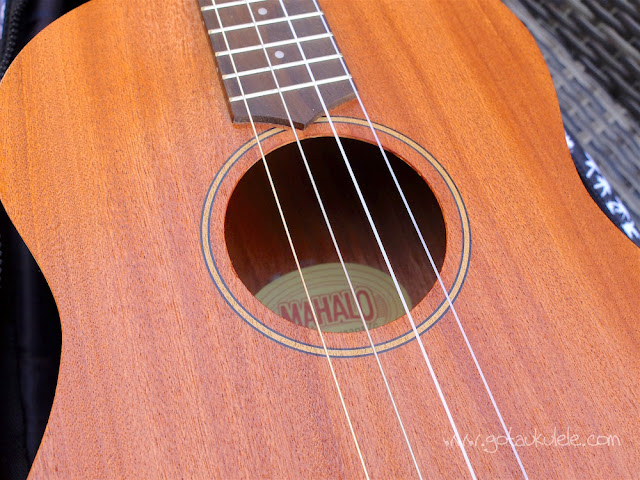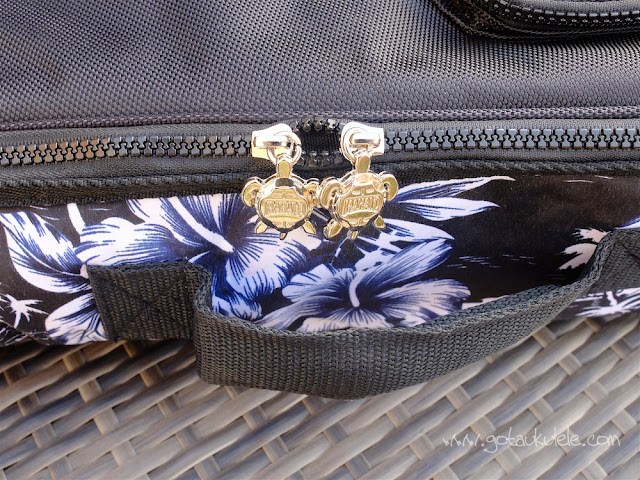Time for another interview on Got A Ukulele and a performer I am delighted agreed to talk to the website. Danielle Anderson, who performs under her stage name of ‘Danielle Ate The Sandwich’ will be well known to ukulele fans around the world, perhaps from her rather excellent YouTube videos (some of which I have shared on this site) but also on account of her extremely well received live performances and enviable songwriting skills.
 |
| Credit - Kaela Speicher |
Hi Danielle! Let’s start off with finding out a little more about how you started in music – what were your first experiences?
'I was in choir in school and church and took piano lessons as a kiddo. I studied violin from 4th grade until I graduated high school. I had always loved writing stories and poems! I have a notebook with songs I wrote from about 5th or 6th grade and some old cassette tapes with me singing some of my early songs. I taught myself to play guitar in high school, but kept my songs a secret until my early 20s! That also when I found the ukulele! I’m a late bloomer, so when I finally came out of my shell it was a bit of an explosion!'
So have you been mainly playing ukulele since or do you have other instruments at home?
'I play mostly ukulele, but this winter I got an electric guitar (with amp and effects) and a banjo. I think that different instruments can help unlock new songs or paths of creativity. Just like if you get a new haircut, you might walk a little bit differently down the street. Ukulele is a true love of mine, but I am willing to have flings with other instruments!'
That’s what I regularly tell my readers – it’s healthy to enjoy all sorts of instruments. Flings are allowed! Aside from the instruments themselves, what styles of music are your real loves?
'What I listen to on a daily basis and what inspires my music are a bit different! I love to find inspiration from folk, jazz and soul music. The lyrical styles found in all of them inspire my own, but I always love pop/jazz vocal melodies and as I develop my singing voice more, I love to let loose with some soul singing! In the car, I listen to pop radio and house/electronic music. The last album I got was Justin Bieber’s Purpose and I love it. It usually surprises people that I like mass consumed radio and cable TV.'
I’ve picked up a soul vibe on the vocals in many of your videos – is there a style you haven’t yet attempted as Danielle Ate The Sandwich but would like to? Do you think everything can work with the ukulele?
'There are songs I love, but can’t seem to make work well with just voice and ukulele. I don’t think that is a limit of the ukulele, so much as it is a limit of my own musical know-how. There are ukulele players who make it obvious to me the ukulele can do anything! James Hill is one of these players-he does Michael Jackson and Jimi Hendrix and his own amazing originals. I am proud to have been able to cover a lot of genres-soul, jazz, pop, rock, country. I would love to do some James Brown and have been working on a Doris Day cover for a long time now!'
 |
| Credit - Corey Hardwick |
Like many artists on the ukulele circuit, you generated a lot of early success with your YouTube videos – how important do you think that channel is for new performers to get noticed?
'YouTube was a very important part of how I got my start and success! I think it’s a great help, but I don’t think it’s essential to success. I know a lot of people ask me how they should get started on YouTube and how they can get big there, but I think it’s a very hard thing to cultivate and it certainly not for everyone. It worked well for me because I got on right when it got big and I’m a goofy performer who loves to be in front of the camera. I don’t think anything I am doing is necessarily right for another musician and vice versa. I should do exactly what they’re doing and expect the same results. I believe that just like finding your musical style and artistic vision, you need to carve your own business path!'
And how did the ‘Ate The Sandwich’ name come about?
'It was in 2006, when i was making a myspace page for my music. I had to pick a URL for the page, so I was making a list of things to call myself and it came to mind. I think food (as an essential building block of life, as well as a visual thing) is fun and lovely. I like the word Sandwich-it’s got nice heavy consonants and sandwiches come in many different shapes and sizes! I didn’t want to change my last name or use a fake stage name, so I just thought what do you do with Sandwiches, you eat them. I’m Danielle, what do I do to Sandwiches? I eat them.'
As a musician, what do you get the biggest buzz from? Songwriting, live performance or a mix of all those things?
'Definitely a mix! I am a songwriter. I am living every day of my life, observing and experiencing every moment as a songwriter. It’s the difference between the question, “What do you do for a job?” and “Who are you?”'
That’s a good point. So tell me how the performance element gives you a buzz?
'Performance is something that I discovered I love in the last 10 years. It makes me feel alive in a different way! When I’m on stage, I’m brazen and liberated. I say what I think and I feel good about myself. The connection between the audience and a performer is really important to me. It’s wild to be two different people, one very timid and observing very quietly and another on fire and up in front of everyone!'
Does that feeling of being on fire come naturally to you? What are your tips for dealing with stage fright and nerves?
'I wasn’t always good on stage! It took me a very long time to face my fears and perform for the first time. When I finally found the courage to get up there, I had to perform several times before I enjoyed it. I was critical of how I did and usually got off the stage feeling terrible about myself. I was always saying, “That was terrible Danielle, but you can do better, you’ve got to try again and do better next time.” There was some fire under my butt that kept me getting back up there. I was always self deprecating and a little odd on stage, so my schtick is natural in the way that it happened the very first time I got up to perform and I’m still doing that today. The experience I was personally having got better and better as I got more experience on stage. I think of stage performance a lot like learning to play a song. You have to practice. You have to do it over and over, know what you’re doing if you mess up, know what you’re doing if you’re doing well, you have to know how to do it when people are talking or when people are REALLY listening. Performance is a skill and an artform! I really like it!
Audiences in the UK and Europe will be thrilled to see you are on the bill for this years Grand Northern Ukulele Festival. Is this your first time over to the UK?
'I travelled to Scotland in 2013 with friends, but didn’t play any shows! This will be my first time in England and my first time performing in the UK! It feels like a very important step for me professional as well as a person! I’m looking forward to the adventure!'
 |
| Credit - Mercedes |
Well I think you are at one of the great ukulele festivals and am sure you will go down well. Of course you have played many other great places already! What would you say is a performance highlight in your career so far?
'I’ve done a few fancy things that people always like to hear about. I got to play the NPR Radio show, ETown with Mumford and Sons. I’ve also opened for Suzanne Vega and I’ve opened on tour for Pomplamoose. I’ve had a few experiences that were very rewarding and personal to me. Sometimes playing a show can be just like another day at work and other days you’re overcome with gratitude and emotions, getting to play your songs and getting to be where you are, sharing it with people.'
Wow! some great names there! What about venues?Do you have any dream stages or events you would like to play?
'My biggest (silly) dream is to be on Saturday Night Live as the musical guest and host! I’d also love to play larger, historic theaters and venues-the same kind of places where Damien Rice and Glen Hansard play! It’s great to be in a venue that helps bring alive your voice and songs, but can still be an intimate setting for you and your fans!'
Naturally, my readers are always keen to know what instruments artists use – tell us a little about your performance instruments.
'My first choice is always the ukulele! I play tenor the most often, but recently got into the baritone. My latest album, ‘The Drawing Back of Curtains’ was almost all baritone ukulele! And I find it’s been a great tool for writing! I play Mya-Moe brand ukuleles. I also play guitar occasionally and just got a banjo! I love to write on any instrument I can get my hands on, but the ukulele is really my strongest writing partner!'
I saw that you play Mya-Moe ukuleles – and obviously there is a connection there with Aaron Keim who you have also appeared in videos with. Are you pleased to be sharing the bill with Aaron and Nicole at GNUF? (nb readers - as well as being a performer, Aaron is a builder with Gordon and Char Mayer at Mya-Moe in the USA)
'I’m thrilled to be sharing the bill with The Quiet American! They are very fun people! I love their knowledge of folk music and Americana and the information they can share about playing the ukulele in their workshops is amazing! I always try to sneak into the class they’re teaching! They have also been great sources of wisdom for me through my music career and life.'
Finally – the question that I end all interviews with… Let us know your best piece of advice for ukulele beginners?
'Keep it in tune and give yourself time to learn chords and learn how to switch easily from one to another! That’s the hardest part in the beginning! Also, don’t be afraid to challenge yourself to learn the next thing that may seem hard and impossible! I have that problem myself-pushing through the difficulty and practicing enough to master a new skill! Most importantly, have fun with it!'
Thanks Danielle – looking forward to seeing you play at GNUF this year!
Danielle Ate The Sandwich is one of the headline performers at this years Grand Northern Ukulele Festival in Huddersfield UK from 27-29 May.
Take a listen to one of Danielle's more recent songs below!
http://danielleatethesandwich.com
http://northernuke.com
https://www.youtube.com/user/daniellesmagic
© Barry Maz





















